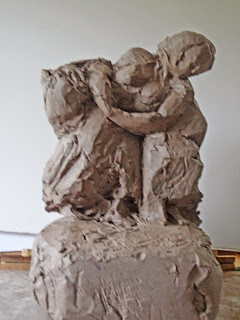Post May 2015:
Honoré Daumier.
“Le Faudeau.” The Heavy Burden. 1850–1860. Oil on panel. 39.7 x 32.2 cm
Collection:
Amgueddfa Cymru – National Museum Wales
DAUMIER NOTEBOOK
, Dec.2014-----------------------------------------
I can’t now
remember why I knew the Daumier painting, “Le Faudeau.” was in the national
collection at Cardiff. I was not aware
of having seen it there but the moment I read the proposal for our present
project it leapt to mind as the work I would like to re-interpret and re-make. That’s
not very interesting, what is interesting is that I had remembered it wrongly. Vividly but wrongly. I was sure the woman in
the picture had a child tucked under her arm and was hurrying away from some scene
of danger.
I have often
wished that I was a political cartoonist or that I could at least sometimes do
a work that was politically committed. I
feel full of protest at all the usual injustices of life . ”The insolence of office, the
oppressor’s wrong...etc” and yet I never do anything to oppose those wrongs. Painting is not a good vehicle for
protest, it is most glorious when it is celebrating something beautiful. It is
very out of fashion to aim for something beautiful these days, perhaps that is
because it seems almost frivolous in the face of the horrors we know exist
around us, every day and nearly everywhere.
I understand how
compromised I am, a tube of good cadmium red or yellow costs enough to feed a
family for a week in a refugee camp. With thoughts like that in my mental baggage
it’s easy to see how attractive Daumier’s basic use of paint would be to me. Earth colours, large simplified areas of
light and dark with few tonal variations deliver the emotional content economically
and with a sense of urgency.
Yet in the end it
is because of the aesthetic qualities in his work that Daumier stands out as of
lasting value among cartoonists.
The other aspect
of Daumier’s work that I would happily be influenced by is his modelling
technique. There are two small relief plaques in the “D’Orsey” . The figures, a line of refugees, emerge from the clay in a
wonderfully organic way. I always intended to do a piece of work of that sort,
in his footsteps.
His relief style is
modern, almost cubist. Compare the plaques with the baptistry doors in Florence
by Ghiberti; there the background is very low relief almost like a drawing on a
flat ground and the figures are like little dolls stuck on top.
Daumier welds the
figures with the background, the figures EMERGE
from the background. As they do
indeed in many of his paintings. In fact many of the paintings might have been
done with sloppy clay, smeared and dragged into an image. Painting with mud,
the poor man’s paint. The cave man’s paint.
The little laundress
hurrying home with her heavy burden is more fully emerged than most. There are
six or seven versions of this painting, I prefer the Cardiff one. The others
seem to show the signs of the difficulties Daumier had with painting, for three
years he struggled to make his living as a painter rather than as a
journalist-cartoonist. He failed and had to go back to journalism.
Whether it was
done first or last our Cardiff one seems spontaneous and easy, a quick little
sketch of something he has seen. It is the innocent vision of someone in love
with life, not using his images to portray what he hates but to express what he
loves, what makes him happy. But also someone who has seen a fellow human being
one day and understood her problems with his experienced compassion. He admires her. His empathy shows, the way she
is using her hip to help support the weight of the basket, that basket is very
heavy. She is brave with the commonplace bravery of the millions who have to
get up every morning and go to work, and determined, she does what she has to
do to live, and she’s a good mother, she trusts her child to keep up with her.
The child is intent on doing so. Neither of them is critical.
Daumier was
critical as well as compassionate, he was imprisoned at the age of 24 for being
on the wrong side in one of that era’s endless twists of political chance. He can be savage and ugly, where he hates.
That’s fine when his villains are the epitome of callous and corrupt power, lawyers
and their political and military masters. (When they are liberated women,
bluestockings and suffragettes the drawings make him seem to be a typical male
chauvinist pig, part of the problem. Oh dear!)
Well my laundress
is fleeing from poverty, her enemy is faceless. Her background looms over her,
thick and threatening; she has to get the washing done and dried before she and
her child will eat again.
I want to do a
piece of work that protests but does not add to the squalor. I hope I will get the backup I need to do it
partly from my chosen painting and partly from the fact of being engaged in this project.








No comments:
Post a Comment